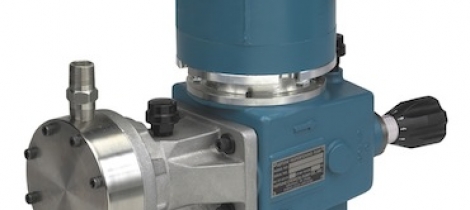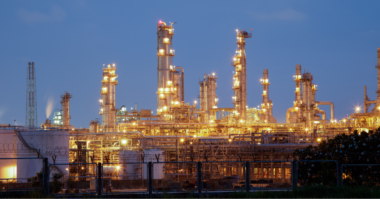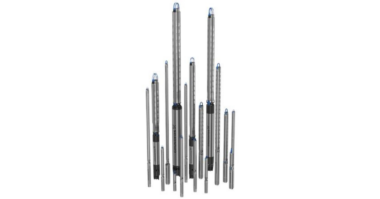The Challenge
At their simplest, metering pumps are used to inject liquids at precisely controlled, adjustable flow rates, which is a process that is often called “metering.” As defined by the Hydraulic Institute’s Metering Pump Section, controlled-volume metering pumps are reciprocating positive-displacement pumps that are typically used for the injection of chemical additives, proportional blending of multiple components or metered transfer of a single liquid.
Metering pumps are used to pump chemical solutions and additives that are used in products manufactured in a wide variety of industries. They are designed to pump into low or high discharge pressures at controlled flow rates. Metering pumps normally consist of a solenoid drive or a gearbox with a motor, a control mechanism, plus a pump head with valves—through which the liquid being pumped enters the inlet connection and exits the discharge connection.
When speaking specifically of the municipal water-treatment industry, the metering pumps that are used must be able to dispense accurate chemical dosages the first time and every time thereafter in order to ensure proper chemical treatment of drinking water or waste water while being processed within the plant. Nearly every process within the water and waste water plant requires metering pumps to dose treatment chemical for disinfection, filtration, clarification, coagulation, flocculation, etc. Metering pumps meet these requirements because they have the flexibility to easily vary the amount of chemical dosage rates, according to the process conditions. They are also ideal in handling a wide variety of corrosive or viscous liquids, as well as acids, bases and solvents.
Taking all of these parameters into account, metering pumps rightfully remain one of the most versatile and relied-upon technologies for the safe, accurate and efficient injection of a unique array of chemicals in municipal-water and wastewater applications. The goal of this article is to help the user define the variables that need to be evaluated when choosing and installing the proper metering pump or complete chemical-feed system. Selecting the proper metering pump and planning a complete chemical feed system will not only help inject liquids or slurries regardless of viscosity, but also ensure that it is done in the most efficient, environmentally/community friendly and energy-wise manner.
The Solution
As seems to be the case with most everything, size really does matter when determining the proper metering pump to be used in a water-treatment application. More specifically, the size in terms of capacity of both the pump’s flow rate and discharge pressure. Simply put, metering pumps should not be oversized. In fact, a metering pump should be sized so that its maximum expected flow rate is 85% to 90% of the pump’s capacity, which leaves additional capacity, if needed. At the other end of the spectrum, a metering pump’s minimum capacity should never be less than 10% of the capacity; anything less will in many cases affect the pump’s accuracy.
Selecting a metering pump can’t be done until the proper flow rates, discharge pressures and type of fluids are identified per specific application. Once that is determined, the type of metering pump can be selected, i.e. hydraulic diaphragm, mechanically actuated diaphragm, solenoid driven or piston style. Hydraulic diaphragm pumps are a popular selection because of their longevity and robust design. Most hydraulic diaphragm pumps handle clear liquids with viscosities generally ranging from water—which has a viscosity around 1 cps at 20º C—to 1,500 cps. Special liquid ends for applications outside this viscosity range are available. Special heads with disc diaphragms are available for hydraulic diaphragm pumps to handle viscosities up to 5,000 cps. When considering true slurries or liquids with higher viscosities utilizing a hydraulic diaphragm pump, special tubular diaphragm heads are compatible with fluid viscosities to 20,000 cps and slurries that contain up to 10% solids.
Another key determination is materials of construction. Selection of a metering pump must take into consideration any corrosion, erosion or solvent action that may occur when handling specific substances. For example, solvents may dissolve pump heads constructed of plastic, acids and caustics may only be compatible with stainless steel or certain steel alloys, and abrasive slurries can erode some materials.
Therefore, the best lines of metering pumps will be available in a range of materials of construction, allowing the end-user to choose the best option for his specific applications.
When considering the type of head the pump should feature, remember that double-diaphragm heads with leak detection and alarm capabilities are available for applications where any diaphragm failure must be sensed immediately.
Selecting a driver is also an area of concern. A driver should be chosen by matching it to the available utilities, which usually include electric, air, gas or other means of driving the pump. When the pump’s parameters are determined, you must then consider the environment in which the pump will operate. Hazardous-area requirements must also be identified when selecting the driver. When evaluating a hazardous environment, remember to consider dust, which can ignite, just like fumes or vapors. Is the pump to be utilized indoors or outdoors? If it’s located outdoors, it should be sheltered from direct sunlight. As far as temperature requirements, most pumps will operate in freezing conditions provided that the fluid to be pumped will not freeze and that the correct lubricants are selected. In this case, freeze protection and heat-tracing may be required, while operation in corrosive environments may require special pump coatings.
Determining the pump’s method of control is next on the list of determining factors. The choices usually include manual continuous operation, on/off operation or automatic proportional control in response to a process signal.
In general, metering-pump flow rates can be manually adjusted through the use of a micrometer dial. This manual control allows the pump to be operated between 10% and 100% of capacity by changing the stroke length. By comparison, a manual variable-speed drive changes the stroke speed. A combination of the two may allow additional adjustability or turndown over the range of the drive, depending upon the stroking speed of the pump. For example, a pump operating at 75 strokes per minute (which could be turned down to 15 spm) would allow a 5:1 turndown on speed when using the variable-speed drive and a 10:1 turndown on stroke length when using the micrometer dial.
Metering-pump flow rates can also be controlled automatically (in response to a process signal) by electric positioners that change the pump’s stroke length, or by variable-speed drives that alter the stroking speed. Using a positioner gives the operator a full 10:1 turndown, which is the full adjustable range. Using a variable-speed drive will supply only as much turndown as the ratio of the pump stroking speed divided by the minimum operating speed of the pump.
Be reminded that it is not practical to use a variable-speed drive on motor-driven pumps that normally operate at less than 100 spm. Slowing the motor causes each stroke to take longer from start to finish and, as a practical matter, hydraulic motor-driven pumps should not be operated at less than 15 spm. Electronic diaphragm pumps, which are pulsed by a solenoid, can operate at less than a single stroke per minute because the characteristic and timing of each stroke, from start to finish, is the same at all stroking speeds. The moving parts in modern diaphragm pumps offer long, reliable service at all stroking speeds. The highest stroking speeds should be avoided with viscous or abrasive chemicals.
When a metering pump is controlled by automatic or electric stroke positioners, the number of doses remains constant and the size of each dose is reduced, thus keeping the doses uniformly distributed in a constantly flowing line. Use of a variable-speed drive changes the stroke speed, while the size of the dose injected on each stroke remains the same, but makes the doses less frequent as the motor speed is slowed. This, however, can produce an undesirable process result in a constantly flowing line as the discreet slugs of chemical are more widely separated than if a constant dose interval were maintained.
Finally, consider the application and level of quality. Is the unit to be used for intermittent operation in an HVAC or light-duty applications where economy is an important consideration? Is the unit for an industrial plant/waste-treatment facility/refinery/power plant where ruggedness and additional features are required? Is initial cost or life-cycle cost more important?
Conclusion
In municipal water-treatment applications, metering-pumping technology that comprehensively offers the best in operation, reliability and energy efficiency when handling a wide array of liquids, chemicals and slurries is the way to go. In a world where the best water-treatment facilities strive to optimize production schedules, efficiencies and energy costs, having the best chemical-metering pumps on hand makes meeting those goals much easier and safer.
Tom O’Donnell is Senior Product Specialist for Lansdale, PA-based Neptune Chemical Pump Co., an operating company with the Pump Solutions Group (PSG™). Mr. O’Donnell can be reached at Tom.ODonnell@neptune1.com or 215-699-8700. PSG is comprised of six leading pump companies-Wilden®, Blackmer®, Griswold™, Neptune™, Almatec® and Mouvex®. You can find more information on Neptune Chemical Pump at www.neptune1.com and PSG at www.pumpsg.com.





Thanks for explaining that the highest stroking speeds should be avoided with abrasive chemicals because I didn’t know that. I’m trying to figure out how to use my new metering pump. What stroking speeds should you use for abrasive chemicals?